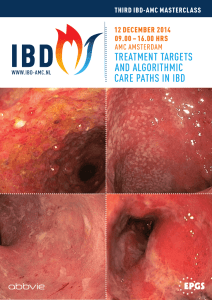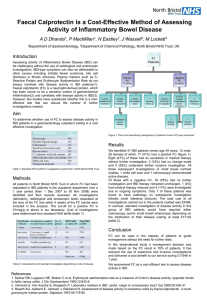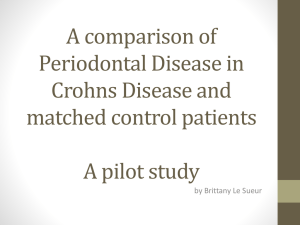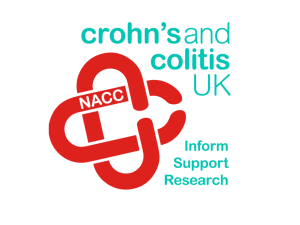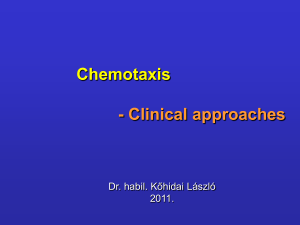Alteration of Chemotaxis in the Gut of IBD Patients
advertisement
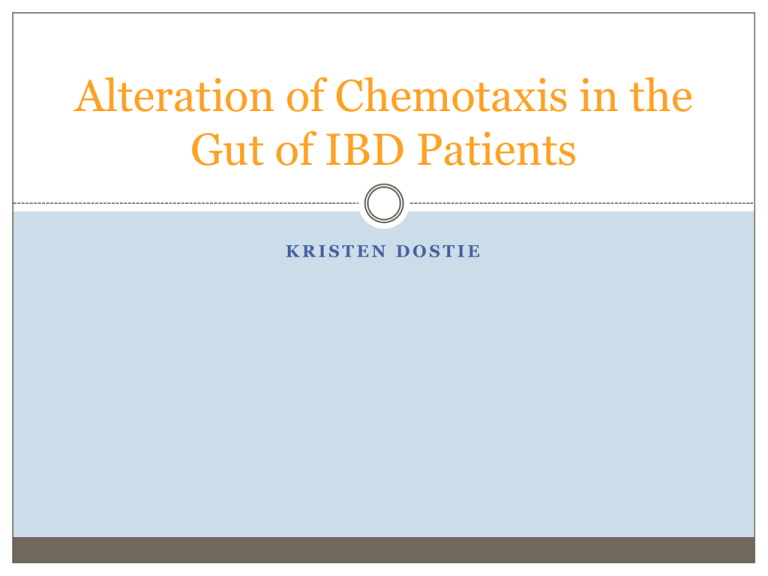
Alteration of Chemotaxis in the Gut of IBD Patients KRISTEN DOSTIE Overview Introduction What do we know about neutrophil chemotaxis in IBD? Paper 1 Paper 2 What is still unknown about neutrophil chemotaxis in IBD? Specific Aim The Inflammatory Response http://www.uic.edu/classes/bios/bios100/lecturesf04am/inflammation01a.jpg How are neutrophils recruited from the bloodstream to the affected area? Chemotaxis! Movement of a cell in response to a chemical stimulus CXC chemokines are ligands for CXCR receptors on several different cell types Promote neutrophil migration Neutrophil infiltration is largely mediated through binding of CXCR receptors Nature Reviews Immunology 13, 649–665 (2013) Overview Introduction What do we know about neutrophil chemotaxis in IBD? What is still unknown about neutrophil chemotaxis in IBD? Paper 1 Paper 2 Specific Aims What is generally known about neutrophil chemotaxis in IBD? Invasion of neutrophils into the mucosal epithelium and intestinal lumen correlates with disease activity Neutrophil infiltration disrupts epithelial barrier integrity Allows lumenal proteins and microorganisms to breach the submucosa Neutrophils within the mucosa and submucosa produce proinflammatory signals that perpetuate neutrophil recruitment to the affected area What is generally known about neutrophil chemotaxis in IBD? Neutrophils release a plethora of inflammatory mediators that can exacerbate inflammation Inflammatory Bowel Disease. Volume 19, Number 7, June 2013 Overview Introduction What do we know about neutrophil chemotaxis in IBD? Paper 1 Paper 2 What is still unknown about neutrophil chemotaxis in IBD? Specific Aims Paper 1 Paper 1 Background Neutrophils produce proteases that cleave collagen into prolineglycine-proline (PGP) Matrix metalloproteinases (MMPs) Prolyl endopeptidase (PE) PGP has been shown to be a chemoattractant for neutrophils via CXCR1/2 in several lung diseases Goal: to investigate the role of PGP in neutrophil recruitment associated with IBD Figure 1: Is protease expression upregulated in the colon of IBD patients? Conclusions: MMP8 is upregulated in both inflamed and noninflamed IBD intestinal samples MMP8 present in IBD patients exists dominantly in its active form Figure 1 (cont’d): Where do these proteases localize within the intestine? MMP8: weak expression in neutrophils and inflammatory cells MMP9: neutrophils PE: neutrophils and epithelial cells Figure 2: Are products of MMP and PE activity increased in IBD? N-Ac-PGP (an acetylated form of PGP) expression is increased in IBD patient intestinal samples. Figure 3: Do IBD neutrophils produce more proteases and their subsequent products compared to healthy controls? Proteases Chemoattractants Conclusion: IBD neutrophils produce significantly higher levels of MMP8, MMP9, and N-Ac-PGP in conditioned medium Figure 4: Protease expression in a DSSinduced colitis model • PE: no significant difference in expression • MMP9: significant increase in expression • MMP8: no significant difference in expression • Conclusion: protease expression in DSS-induced colitis colon samples is comparable to human IBD tissue levels. Figure 5: Localization of protease expression in DSS-induced colitis colon tissue • MMP8: leukocytes and epithelial cells • MMP9: leukocytes • PE: leukocytes and epithelial cells • Conclusion: localization of proteases is comparable to patterns in human disease. Figure 5 (cont’d): Chemoattractant expression in DSS-colitis colon tissue Conclusion: N-Ac-PGP and PGP are generated in DSS colon samples, but not at significant levels. Figure 6: PGP neutralization as a therapeutic for IBD Conclusion: PGP neutralization reduced disease activity index (DAI), shortening of the colon, histopathological scores, and neutrophil infiltration in the colon. Figure 7: The PGP generation cascade leads to neutrophil chemotaxis Conclusions from Paper 1 Components of the PGP generation pathway (matrix metalloproteinases and PE) are present in intestines of human IBD patients and DSS-induced colitis mice. N-Ac-PGP-mediated neutrophil recruitment likely plays a role in the perpetuation of intestinal inflammation of IBD PGP neutralization reduced neutrophil infiltration and disease activity indices in a DSS-induced colitis model Overview Introduction What do we know about neutrophil chemotaxis in IBD? Paper 1 Paper 2 What is still unknown about neutrophil chemotaxis in IBD? Specific Aim Paper 2 Lumican Found in connective tissue rich in fibrillar collagens Deficiency impairs connective tissue function Promotes neutrophil migration by interacting with neutrophil migration receptor MAC1 or CD11b or CD18 Expression is upregulated in epithelial cells after injury Goal: characterize the role of lumican in regulating immune response during inflammation http://onlinelibrary.wiley.com/doi/10.1111/febs.12210/full Figure 1: Summary of TNBS colitis model Figure 2: Response to intrarectal TNBS treatment using saline or ethanol as controls Conclusion: Lum -/- TNBS-treated mice displayed more pronounced adverse effects to TNBS treatment than the WT strain. Figure 3: Macroscopic appearance of Lum +/+ and Lum -/- colons from saline vs. TNBS-treated mice Figure 4: Increased inflammation of colons in Lum+/+ and Lum-/- mice Conclusion: colonic edema and swelling is increased in Lum-/- mice. Figure 5: Is early acute inflammatory response T cell-mediated or innate immune driven? Rag1-/- mice do not have mature B or T cells. Conclusion: Early stages of TNBS induced colitis involves an innate immune response Figure 6: Histology of colon cross sections from Lum+/+ and Lum-/- mice Figure 7: Inflammation scores and MPO expression Conclusion: Lum-/- colons have more tissue damage but less neutrophil infiltration after TNBS colitis induction. Figure 8: Induction of proinflammatory cytokines in inflamed colonic tissue Conclusion: TNBS colitis induced CXCL1/KC and TNFα production in Lum+/+ but not Lum-/- colonic tissue. Figure 9: NF-κB activation in Lum +/+ vs. Lum-/- mice 1º peritoneal cells Conclusion: delayed nuclear localization of NF-κB in Lum-/- colonic samples suggests a weak innate immune response in the absence of lumican. Conclusions from Paper 2 Lumican deficiency leads to decreased neutrophil infiltration but increased severity of colitis Lumican plays a role in regulation of inflammation in colitis CXCL1 TNF-α Neutrophil recruitment What is still unknown about neutrophil chemotaxis in IBD? Well, a lot of things. ECM proteins and their degradation products Several are ECM proteins are upregulated in inflamed colonic tissue of IBD patients Neutrophils themselves produce proteases whose products further perpetuate their infiltration Role of upregulated ECM proteins in the perpetuation of neutrophil infiltration in IBD is poorly studied. Mechanism of action of ECM proteins/protease products on neutrophil recruitment is poorly understood Specific Aim and Future Directions Specific Aim Determine a set of ECM proteins and their degradation products upregulated in inflamed colonic tissue in IBD that can be chemoattractants for neutrophils Potential experiments Electric cell-substrate impedance sensing (ECIS)/Taxis to determine potency of chemoattraction induced by various ECM proteins and degradation products Determine mechanism of action of these proteins by blocking CXCR receptors Thanks for listening!

